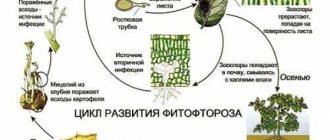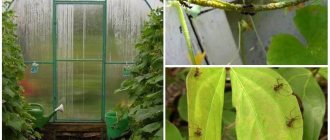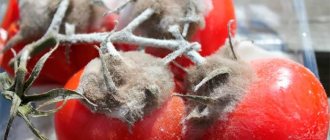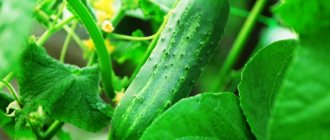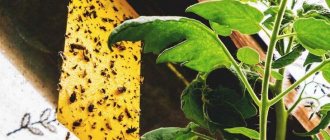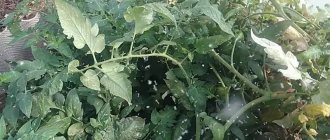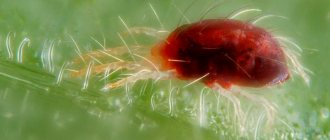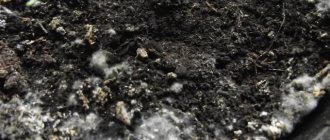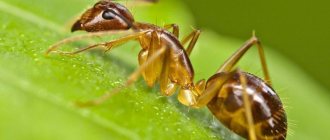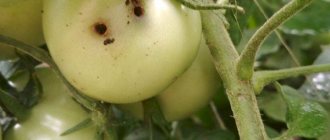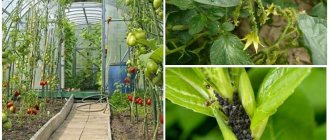Our reader Olga Gritsaenko, in the “Flowers in My Garden” group on Facebook, posted a photo of a weed that had wrapped itself around all the new potatoes. Wondering what kind of plant this is and how to fight it. Let's try to answer her questions.
After discussion, most participants came to the conclusion that this is a field dodder. And we agree with them. Dodder is a very dangerous and difficult to eradicate weed. It harms not only garden plants, but also meadows and even trees and shrubs.
Characteristics of dodder and its harm
The second name of the plant is “garden tangle”, “yellow cobweb”. It has a yellow-red stem that encircles all the plants in the garden. There are more than 250 species of dodder in the world, but in our country there are mainly a few that grow:
- European;
- thyme;
- linen;
- clover
The plant is distributed in 164 countries. It looks like a long cord covered with scales and strewn with pink, white, and green small flowers. The parasite begins flowering between April and July. The stem grows to 26-30 cm in length.
Living on the donor's body, the dodder sucks the juices out of it, leading to the death of the plant. It is attached using suction cups called haustoria. One instance of the pest can infect dozens of neighboring plants. Light-loving dodder is usually located in the upper or middle tiers of plants. A plant without roots and leaves can destroy fruits in the garden and garden in a few weeks.
Types of dodder differ in thickness, growth rate, and number of branches. Most of them are omnivores. They entangle bushes, trees, cultivated and wild plants. Dodder can often be found in meadows (the parasite loves alfalfa, clover and other grasses for food).
In a garden or city, the plant attacks vegetables, legumes, berries, flowers and fruit trees
Damage caused by dodder:
- Drinks the juice of the donor plant through suckers-haustoria.
- Infects garden plants with viral particles that cause plant death.
- Slows down the growth of the donor, which leads to a violation of the ratio of mineral compounds and organic substances.
- Violates the winter hardiness of plants.
- It weakens the covering tissues of plants, causing them to become sick.
- Reduces the quality and quantity of the harvest (by 20-40%).
- Hay affected by the parasite loses its nutritional value and becomes unsuitable for livestock.
- The plant penetrates so deeply into the donor’s body that it can only be gotten rid of along with the planted crop.
Livestock suffers from the alkaloids contained in dodder. Animals eat hay affected by the pest and are poisoned by the couscudin and kustalin it contains.
One weed vine produces 1,000,000 seeds, which can live without a donor for a long time, and can sprout even after six years. Thanks to the movement of nutrients inside them, the seeds are able to move short distances (up to 35 cm).
Important! A distinctive feature of the parasite is its ability to make seeds similar to the seeds of the donor plant. When planting your favorite plant in the spring, there is a risk of planting harmful weeds along with it.
If you are interested in how to remove dodder from the garden, you need to study how it gets there.
The pest enters through:
- insufficiently cleaned seeds of field crops;
- vehicles;
- agricultural equipment;
- irrigation canals;
- fertilizers;
- grain waste.
Often dodder seeds are spread throughout the field by a combine harvester and labor tools. Less commonly, seeds are brought by wind, livestock and birds, rainwater, and wild herbs.
Dodder can survive even a cold winter or a period of drought, so getting rid of it will require a lot of effort.
Why is dodder dangerous?
This photo was posted in the Flowers in my garden group on Facebook by Olga Gritsaenko
Dodder is a parasitic plant. Living at the expense of the “master”, she sucks the vital juices out of him, slows down his growth and does not allow him to develop normally. In perennial plants, winter hardiness decreases, this can lead to their death. What can we say about productivity? In some crops, its losses reach up to 95%. It is no coincidence that all types of dodder in Russia are classified as quarantine weeds.
Today, 165 countries in the world suffer from dodder alone. In total, the weed has over 270 species, with about 40 in Russia alone. This native of the tropical forests of Africa and America is extremely tenacious and prolific.
He, like the mythical hydra, can recover from a small part of himself remaining on the host plant. And if you consider that one unit of this weed produces up to 100 thousand seeds, then the threat is quite obvious.
Dodder is dangerous not only to flora, but also to fauna, because contains poisonous alkaloids. They cause serious poisoning in animals that eat dry weed along with hay.
In addition, dodder is a carrier of many viral diseases. Meadow grasses that are not cleared of weeds become moldy and dry poorly.
How to get rid of it using mechanical methods
Since it is unrealistic to destroy weed thickets with one method, a whole range of measures will be required. First of all you need:
- Pull out all the stems and seed pods in the garden and burn them outside. While this won't kill all the weeds, it will help relieve pressure on affected plants.
- In the place where the dodder grew, it is worth planting crops resistant to it - oats or wheat.
- If the parasite has tightly wrapped itself around a plant, it is better to uproot it and plant melons, watermelons or cucumbers in its place.
- If the area affected by the dodder is too large, it is recommended to resort to long-term quarantine of the area - for 4-8 years.
- The soil can be watered abundantly. This is done in the fall and spring to speed up the growth of the pest and eradicate it.
Since the seeds are extremely tenacious, even a quarantine placed on the site does not always help get rid of the dodder. The easiest way to destroy it is when it has not yet attached to the donor. The dodder always waits until the planted plant reaches at least 15-20 cm in height, takes root and becomes established, and only then sticks to it. Before she has time to do this, she can be killed both chemically and mechanically.
Manually removing dodder is an ineffective method. If you miss a small part of the stem, after a while a new plant will grow from it. It is best to weed the entire area where weeds were noticed. Having noticed a pest on a single crop, you need to pull it out and burn it. You cannot leave cut weeds in a compost heap. Experienced gardeners collect it in a bucket, put it in the sun to dry, and then burn it.
Morphological characteristics
Field dodder, a parasitic plant, is a typical parasitic plant. The stems are thread-like, yellow or orange-yellow, curly, highly branched, up to 1 mm in diameter. They twine around host plants and attach to them using special structures called haustoria.
Field dodder, a parasitic plant, has no real roots. Leaves are underdeveloped. The flowers are small, white or greenish-white, on short stalks, collected in dense racemes. The calyx is hemispherical, smooth, shiny. The corolla is bell-shaped, with egg-wedge-shaped or triangular petals.
The fruit of the field dodder is an appressed round two-locular capsule containing 2-4 seeds. The seeds are round, irregular in shape, with two flat sides, rough, yellowish-gray or brownish-gray in color with a convex nose. Seed length - 1.25-2.5, width - 1-1.5, thickness - 0.75-1 mm. Weight of 1000 seeds is 1-1.25 g.
Clearing soil from seeds
If dodder seeds get into the soil, it must be cleaned.
They do this in two ways:
More to read:
How to get rid of bindweed on your property forever
- Bury the seeds as deep as possible into the soil. Since the pest can only germinate in a superficial ball of soil (up to 6 cm), digging up the soil with at least two shovels and turning the earth will help “bury” the weed. The plant has no roots, so seeds are not able to germinate from the depths. It is useful to plant rye, oats, timothy, wheat on a dug up area, or even leave it alone for several years. In the future, it can be used to grow pumpkin or melon crops.
- The next method is the deliberate cultivation and destruction of seedlings. The weed seeds are allowed to germinate before the main crop is planted. This way they do not have time to stick to the victim plant. To grow dodder, in autumn and spring you need to water the weeds well two weeks before planting the main plants, and cover it with film. Due to the greenhouse effect, the seeds will sprout quickly. After this, the dodder can be easily removed by mowing. The parasite will disappear on its own if it does not find a donor soon.
The Americans, concerned about how to remove the dodder, came up with the idea of using gas-powered flamethrowers. Although this method can remove weeds, it is unsafe and is used only in a few countries.
Fighting dodder with a fire cultivator
If the meadow is overgrown with dodder, it must be mowed before the plant blooms. If the weed grows in the garden, infected plants must be cut at a height of 2-3 cm above the ground. The same should be done with their neighbors growing at a distance of 1 m. To prevent re-infection, it is recommended to plant the area with cereals.
In the fight against dodder, preparations made from Alternaria mushrooms are used. They only work in damp conditions, so their use is problematic.
After cleaning the soil, black fallow is created next year - the area is not planted with anything and is weeded regularly. In future years, crops that are hated by the weed are sown in the garden - melon, watermelon, cucumbers, zucchini. Melons have strong leaves and stems to which the pest does not stick.
Destruction of seeds
The dodder leaves behind thousands of seeds. They must not be allowed to germinate and re-infest the area. To avoid this, use several techniques:
- Provocation. In stable warm weather, water the soil generously and wait until the weed shoots appear. This may take 1-3 weeks. After this, the area is loosened or dug to a shallow depth.
- Digging. Before sowing useful crops, the soil is dug up to a depth of at least 6–10 cm - so that its top layer is at the bottom. Weed seeds will end up at a depth from which they will not be able to germinate.
Growing sustainable crops.
Some plant species are slightly susceptible to dodder infection. Where it appears, it is recommended to plant just such crops for the next 3–4 years. These are oats, barley, wheat, corn, millet, etc. Dodder seedlings will not be able to attach to them and will die. Your favorite vegetable
Chemicals
In cases where agricultural methods are powerless, herbicides help. They are recommended for use in areas where dodder has spread abundantly. The products of Japanese, German, and Swiss companies show excellent results.
It is recommended to use a separate product for each type of plant. So, a mixture of substances “Stomp” and “Reitar” will help save carrots. For nightshade crops, “Zenkor” and “Gesagard” are used. No less effective:
- "Targa";
- "Titrus";
- "Kerb-50";
- "Pivot";
- "Reglon";
- "Dominator";
- "Roundup";
- "Glyphosate".
Esters and ethylhexyl salts will help remove seeds remaining on the site. They are mixed with ammonium nitrate and ammonium sulfate. You should not use these products if dicotyledonous crops grow in the garden - they, like the weed, will die. It is best to use glyphosates for them (they need to be applied before the plant has sprouted). The optimal time for application is after abundant watering, before planting the main crop.
Important! The older the dodder, the more resistant it is to the effects of drugs. It is best to spray the products after rain or watering - this way their effectiveness will be higher.
“Taifu” or “Dual Gold” give results only when a dose is applied, which is also detrimental to the donor plant. The product must be used according to the instructions, before the crop sprouts or seedlings are planted. Most often, the drug must be dissolved in water and sprayed onto the soil. The drugs are also used at the beginning of plant germination, but then the dose is significantly reduced.
Most chemicals take effect within three hours - they penetrate plant cells, killing them. The pest dies after two weeks. Herbicides do not harm the soil, completely dissolving in it. A year after removing the parasite, it is recommended to repeat the treatment of the contaminated soil with the chemical, regardless of whether the plant appeared there or not.
Getting rid of weeds is not easy, so prevention is very important
Distribution in Ukraine
The homeland of field dodder, a parasitic plant, is considered to be North America, from where it spread throughout the world, mainly together with the seeds of various crops. It was discovered in Europe around 1900, and already in 1914 this quarantine emigrant-aggressor “registered” in Ukraine, in the Odessa region. It was here that the dodder naturalized and began to quickly spread further with the crude seed material of alfalfa and clover.
The last century was extremely favorable for the “dispersal” of this dangerous adventive species, so now it is found in all soil and climatic zones of the country. According to the latest data from the State Veterinary and Phytosanitary Service of Ukraine (as of 01/01/2014), the range of field dodder covers almost all areas of the Steppe, Forest-Steppe (except for Ternopil and Cherkasy regions) and Polesie (except for Ivano-Frankivsk and Rivne regions .) on a total area of about 31.5 thousand hectares. The largest areas of soil infestation by the field dodder weed were noted in Zaporozhye (9239.9 ha), Kherson (6290.3), Nikolaev (5680.1), Odessa (1492.5) regions and the Autonomous Republic of Crimea (7167.5 ha).
It should be noted that in the early 2000s, the area of farmland infested with field dodder reached almost 70 thousand hectares. Therefore, as we see, over the last decade, thanks to the competent implementation of a set of quarantine measures to localize and eliminate outbreaks of this weed, the areas infected with it have decreased by more than half.
In addition, three more types of field dodder are limitedly distributed on the territory of Ukraine: Leman dodder - 4.62 hectares (Crimea, Dnepropetrovsk and Lugansk regions), Odnostolpchikova dodder - 3.94 (Zaporozhye, Lugansk and Kharkov regions), European dodder found only in the Lugansk region (0.001 ha).
Prevention of pest occurrence
The surest way to combat dodder is to prevent its germination on the site. Required:
- Before planting crops, carefully inspect seeds, fertilizers, and equipment. All this may contain dodder seeds. Since the pest seeds are similar to garden crops, you need to be vigilant. If a parasite is detected, the seed material is sent for further treatment or completely disposed of.
- Do not fertilize the soil with fresh manure. Once ingested by cattle, the dodder does not die, but waits for the right moment to fall into the ground along with the manure and germinate in the future. It is better to use humus. Also, seeds should not be allowed to get into livestock feed - through hay, grain waste or green mass.
- It is better to buy plant seeds in specialized stores. This way you can be sure that they have passed a phytopathological examination.
- Dodder loves to entangle thickets growing next to the garden. They need to be mowed and burned periodically.
- Having removed the dodder from the site, the next year it is not recommended to plant seeds of plants that grew near it.
- It is better to buy rotted manure from trusted suppliers. This will give you confidence that the product is clean, and that the dodder seeds, if any remain, have lost their viability.
- You need to be careful about the soil in which the seedlings are planted. You cannot take soil from a field where there are a lot of weeds. It's better to buy it in a store. It is advisable to steam it before sowing the seeds.
- In the spring, before sowing, it is useful to carry out cultivation. They are recommended to be combined with frequent watering.
- Before and after emergence, you need to care for the crops using harrowing. During flowering, do inter-row cultivation and pull out individual infected plants.
- Machinery and equipment used in areas infested with dodder should be thoroughly cleaned before other work.
- It is advisable to observe crop rotation and periodically plant crops that are not affected by dodder - sunflowers, grains.
- The area affected by the pest must be mowed, covering a 1.5-meter guarantee zone. It must either be treated with chemicals or kept in a state of black steam.
- If the dodder has chosen an uncultivated area, the plant on it must be regularly mowed as low to the ground as possible (usually the dodder is located at a height of more than 10 cm).
- If a crop damaged by dodder was harvested from the garden, it is stored separately from the clean crop.
Dodder is one of the most harmful weeds that is difficult to get rid of. The result will be achieved only by systematicity, perseverance and perseverance, coupled with the use of mechanical and chemical methods of destruction.
The use of dodder in folk medicine
Since ancient times, dodder seeds and stems have been credited with numerous medicinal properties. It can thin the blood, cleanse blood vessels, stop bleeding, effectively eliminate rashes, relieve constipation and swelling, and help in the treatment of bronchitis and pneumonia, liver and stomach diseases. It is also used in the treatment of alcoholism, angina pectoris, colic, prostatitis, nervous disorders, and cancer. It has analgesic and antitumor properties.
Absolutely all parts of the plant have beneficial properties. The grass is collected during its flowering period - June - July, and the seeds are collected in September-October. The herb is dried and stored in a dark, cool place for no more than a year, then it loses its beneficial properties.
For various diseases, different forms of dodder-based medications are used:
- Freshly squeezed juice stops bleeding resulting from skin damage. A paste of finely chopped stems helps with bruises.
- To prepare the infusion, add 1 tablespoon of dried herb to one liter of boiling water. It is used for diseases of the throat and oral cavity as a rinse.
- Dodder tincture is made either from 9% vinegar or alcohol. To prepare a vinegar tincture, pour vinegar into fresh herbs in a 0.5-liter glass jar and store for a long time. An alcohol tincture is prepared from dry grass, pouring it with alcohol in the ratio: 0.5 liters of alcohol per 4 tablespoons of herb. Mix and store in a dark place, shaking occasionally. Used as warming compresses for joint diseases.
- A dodder decoction is made from the seeds. To do this, they are boiled over low heat in the proportion: 1 teaspoon per 1 glass of water. The cooled liquid can be used both locally and internally for diseases of the stomach and duodenum, one tbsp. spoon three times a day.
- To prepare dodder tea, add half a teaspoon of dried flowers or stems to a cup of boiling water; it is indicated for women with painful menstruation.
- When making an ointment, use powder from dried herbs, mixing it with butter, then store the resulting mixture in the refrigerator. It helps with various skin injuries, including inflammation, burns, ulcers, and bedsores.
Attention! If, while using dodder as a medicine, you experience nausea, vomiting, dry mouth, dizziness or diarrhea, you should immediately stop using these medications and seek help from a doctor.
Effective ways to get rid of dodder
Getting rid of dodder quickly is fantastic. You will have to tinker a lot, and then take preventive measures. What should you do first?
These measures will improve the situation, but will not destroy the dodder completely; chemicals will also have to be used. However, there are no simple and safe means for destroying dodder: all of them have a detrimental effect on cultivated plants. Preparations based on glyphosate are quite effective: Tornado, Roundup, etc.
Roundup, of course, is not a “gift”, and one can argue with “does not pollute the soil”: after all, it’s an organophosphorus drug, but you can’t do without it
Among other powerful herbicides that kill this weed, but do not act on all cultivated plants, we can mention Reitar, Gesagard, Titus, Targa-super, etc. They begin to work within 2 hours after application, and the complete death of the vegetating dodder occurs after 2 weeks. However, you should remember about the presence of its seeds in the soil, so spraying will have to be repeated this or next year.
And then, after a few years, it turns out that the ill-fated weed has disappeared. Is it forever? Maybe. But to prevent it from appearing again, preventive measures are needed. Most often, dodder is introduced with low-quality seeds, and sometimes they are present in the soil from which the seedlings are purchased. You cannot use fresh manure: for the seeds in it to germinate or die, the manure must be completely rotten. It is necessary to fight other weeds not only on the site, but also in close proximity to it.
Video: gentle ways to combat dodder
The parasitic plant dodder is the scourge of gardeners: it does not appear as often as, for example, dandelion, but it is much more difficult to remove. Control measures must be comprehensive: both mechanical removal and the use of chemicals.
Source
Description of the plant
This parasitic herb has no roots or leaves. The stem is thread-like, sometimes resembling a cord. Its color varies from yellowish, orange to red. The dodder wraps itself around the host plant, penetrates it with its suckers and feeds on the juices. Research shows that the dodder detects its chosen prey by smell. Other names are Povetel’grass, Povelitsa’s grass.
It has flowers of white or pink, less often green. They gather in inflorescences. The fruit of the dodder is a capsule with flat sides. The seeds have a rough and rough surface. The embryo is spiral, bent, thread-like, without a root.
Interesting. Immature dodder seeds are able to germinate faster than mature ones. They remain viable for many years, even up to 10.
Individuals affected by the parasite must be destroyed because they cannot be saved. Dodder camouflages seeds, making them look like seeds of cultivated plants. This increases the risk of introducing a dangerous pest into your garden or garden in the spring.
Dodder grass
Due to parasitism, dodder is able to grow quickly and cover large areas. Just one seed can grow 6 square meters. m. Since increased tissue turgor is achieved in the stems, stem fragments may not wither for a long time and remain viable. This is a specific device. Herbs affected by dodder have very poor nutritional quality and can even lead to the death of livestock. The parasite can spread viral pathologies.
The described weed contains dangerous alkaloids that can poison the body of cattle.
Below is a list of the most common types of weeds:
- Field dodder has thread-like branching stems. They attack plants in the upper and middle parts. This species bears fruit very abundantly. Affects a large number of crops.
- Clover dodder has hair-like green or pinkish thin stems and white dense flowers. It affects grass plants, including alfalfa.
- Clover dodder parasitizes many shrubs and herbaceous plants, as well as weeds. The grass is distinguished by branched red stems.
- Flax dodder has unbranched greenish-succulent shoots of medium thickness. The flowers of this plant are yellow. It can attack flax, clover, bindweed, alfalfa and some weeds, including birch.
- Hop dodder has cord-like branching reddish-brown or dark pink stems. The flowers of this insidious plant are pink. This species is capable of parasitizing trees and shrubs.
- European dodder attacks vetch, clover, alfalfa, tobacco, gooseberries and currants. It has reddish stems and pink-white small flowers. Affects bindweed plants.
All varieties of this pest are equally dangerous and contribute to massive damage to plants.
Interesting. Some plant species have medicinal properties.
How to prevent dodder invasion?
Smart people say that it is better to prevent misfortune than to fight it later. How to prevent dodder invasion? There are simple rules that you can follow to avoid the spread of this harmful weed.
You can infect your plot with dodder through seedlings. If you grow it yourself, be careful how you use the soil. Never use soil from an area where there are a lot of weeds for this purpose; dodder seeds are probably “hiding” in such soil, just waiting to sneak into your garden along with your seedlings.
manure on your site , make sure that it is completely rotted; such manure will definitely not contain viable weed seeds. The untreated water you use to water your garden also carries the risk of contamination, as it may have passed through areas with dodder.
Detection and identification
What’s interesting is that the seeds of many species of field dodder, the parasitic plant, are very similar in appearance (shape, weight and even color) to the seeds of the cultivated plants on which it parasitizes. For example, the seeds of field dodder and creeping clover are so similar that often only specialists can distinguish them. It is believed that this “disguise” of weed seeds as the seeds of the crop affected by them is the result of evolutionary adaptation to a parasitic way of existence. However, in most cases, normally formed and ripened seeds of field dodder, the plant of the parasite, can be relatively easily distinguished from the seeds of other weeds and cultivated plants by a number of characteristic external signs.
If you have doubts about the correctness of determining the species of seeds, you can use a more accurate identification method - by seed embryos. To do this, the suspicious seed should be held over an alcohol lamp until its shell swells. Then, using dissecting needles and a scalpel, the embryo is obtained and examined. In the field dodder, a parasitic plant, it is yellow, spirally coiled, thread-like, 11-14 mm long and, more importantly, without differentiation into a root and cotyledons. If there is only one seed and it cannot be destroyed, then the swollen seed should simply be examined under the seed coat.
